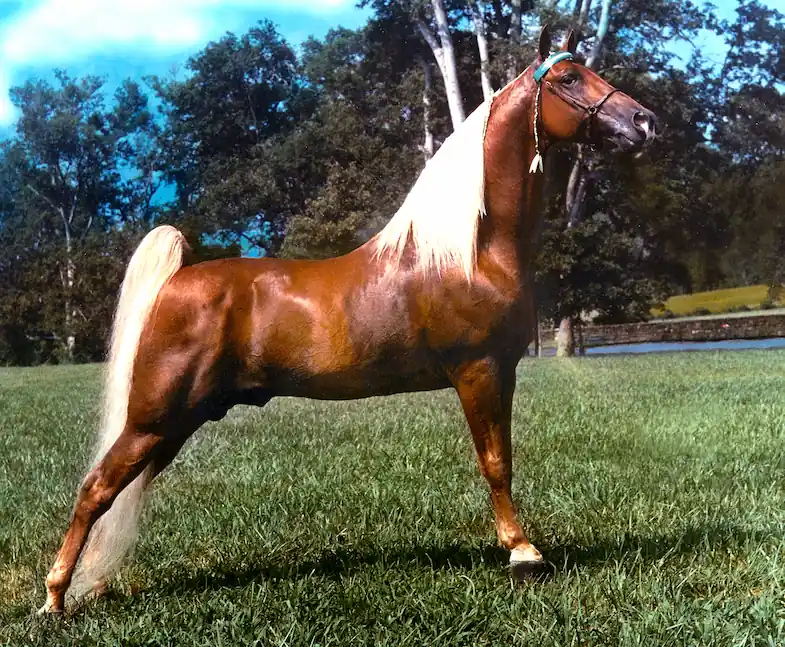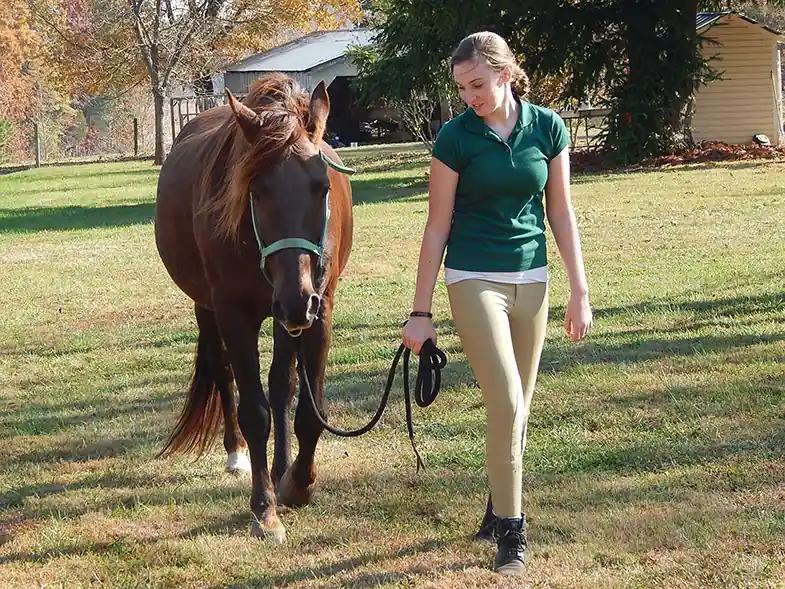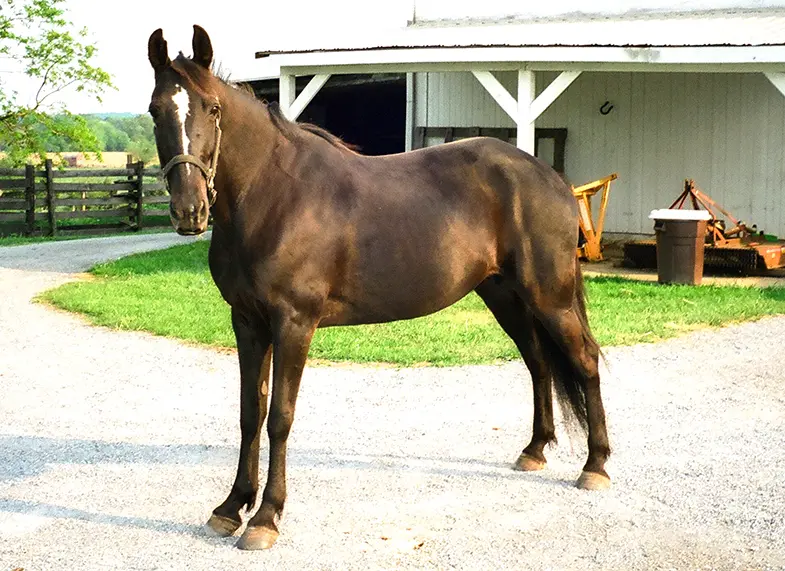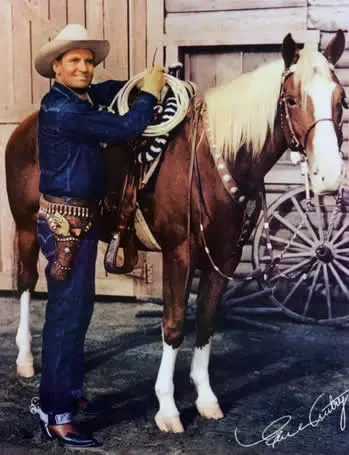Taking its name from the southwestern state where it was first created the Tennessee Walking Horse is one of the most well-known of all gaited horses. Often wrongly thought of as nothing more than an elegant show horse, the Tennessee Walker, as it’s also known, is so much more than just a gaited horse. Read on to find out just how remarkable this beautiful breed is.
Height: The average horse will stand at 15.2hh (62 inches) although anything between 14.3hh (59 inches) and 17hh (68 inches) is allowed.
Color: Black, bay, and gray are the most commonly found colors, but roan, palomino, white and gray can also be found, as can a variety of coat patterns due to the presence of the dilution genes.
Country of Origin: Tennessee, USA.
Registry: Tennessee Walking Horse Breeders’ & Exhibitors’ Association
A multi-breed beginning
Like so many other breeds in the world, the Tennessee Walker evolved by crossing a variety of breeds to produce the breed that’s much loved today. Of course, you’d expect a number of pacers and gaited horses to be used but what might surprise you is that the Thoroughbred was also used.
The breed’s predecessor, the Tennessee Pacer (itself a cross between the Narragansett Pacer and the Canadian Pacer) was crossed with Saddlebreds, Standardbreds, Morgans, and Thoroughbreds to create the elegant, smooth-gaited Tennessee Walker.
Winning isn’t always a recipe for success
You might be surprised to know that the founding sire of the Tennessee Walker was originally bred for the race track but failed to ever make it out of the starting gates. Born in 1886, Black Allan (or Allan F-1 as he was also known) had a pretty good racing pedigree all of his own. His dam, Maggie Marshall, was a Morgan who was a direct descendent of Justin Morgan’s Horse (the founding sire of the Morgan) while his sire, a Narragansett Pacer and Canadian Pacer cross known as Allendorf, is known to have descended from Hambletonian 10 (the founding sire of the Standardbred).
The trouble was that Black Allan preferred to pace rather than trot so never made it to the track. This turned out to be a good thing though and he was later sold to James R. Brantley, a local horseman who saw his potential and immediately started breeding him to produce natural walkers that were smooth to ride.
In his lifetime, Black Allan sired a huge number of foals but the most influential of all of his offspring was Roan Allen (registry number F-38), a stallion who went on to sire over 400 horses.
Originally bred as a utility horse
While the Tennessee Walker is best known as a show horse it was originally developed as a comfortable, yet versatile, utility horse that was used by ranchers and plantation owners to oversee their estates. Sometimes called a Turn Row, due to the fact that these inspections were carried out ‘row by row’, the breed was also known as a Southern Plantation Horse in its early days.
Many ranch owners would spend all day in the saddle so a comfortable horse was a must, on top of that though they also needed a horse that was capable of taking the whole family to church at the weekend.
As well as being a popular working horse with ranch owners its services were also employed by traveling doctors and preachers, both of which needed to cover great distances either under saddle or in a harness.
A truly versatile horse
Despite the breed’s utility beginnings, it has evolved into an all round versatile horse that is truly capable of turning its hoof to anything. This, in part, is thanks to its early use as a riding and carriage horse but also due to the breed’s original breeding ground.
Evolving in the foothills of the Cumberland and Appalachian mountains, the Tennessee Walker, needed to have a confident pace. This sure-footedness meant that, combined with the breed’s comfortable gait, the Tennessee Walker’s popularity as a trail horse was guaranteed.
On top of this, they’re intelligent horses that are eager to learn and keen to please, this makes them great sport and pleasure horses, but also perfect for the show ring. With the correct training, they can even make good jumpers or barrel racers.
A three gaited horse
Of course, the Tennessee Walker can walk and gallop just as well as the next horse, but unlike other horses, they can also perform a flat walk, running walk, and even have a unique canter that is said to be as comfortable as relaxing in a rocking chair.
Flat walk
Similar to the normal walk, the flat walk, which is sometimes called a flat foot walk, is a fast long-reaching walk with each hoof hitting the ground separately. It’s exceptionally comfortable for the rider who almost appears motionless while the horse is traveling at anywhere from 4 to 8 mph.
Running walk
The most well known of all Tennessee Walker gaits, the running walk is similar to the flat walk but is much faster, with the horse reaching speeds of between 10 and 20 mph. While performing the running walk most horses will nod their head in time with their feet as they move while some will even snap their teeth at the same time.
Other gaits
While all horses can perform the flat walk, running walk, and canter some are also capable of performing other, less desirable (especially in the show ring), gaits such as the foxtrot, rack, single-foot walk, stepping pace, and trot.
Walk that walk
Unlike some other gaited breeds that ‘share’ their gaits, the running walk is unique to the Tennessee Walker and is in fact an inherited gait. While it can be emphasized with humane training it can’t be taught to horses that don’t have the ability to perform it.
It’s for this reason that, while some horses may appear to carry out a variation of it, the Tennessee Walker is the only horse that can truly perform a running walk.
Gliding over the ground
Discouraged in many breeds, the Tennessee Walker is famous for its ability to overreach its stride. Known as overstriding, it’s particularly evident in the running walk and gives the breed its distinctive, graceful, flowing movement.
This gliding movement happens when the hind feet slide into, and over, the tracks left by the front feet, often overstepping them 6 to 18 inches.
A perfect breed for beginners
If you’re new to horses (whether it be riding or ownership), the Tennessee Walker is the perfect horse for you. Their calm, gentle natures make them easy to handle while their sensible disposition means they’re not prone to spooking.
Being intelligent horses, they’ll always be willing to learn with their owners and are forgiving of genuine mistakes.
The studbook was closed in 1947
In 1935 the Tennessee Walking Horse Breeders’ Association (TWHBEA) was formed to promote the breed as well as to protect its bloodlines. One of the first things it did was set up a studbook to help set the breed standard and record influential horses.
Within less than ten years, in 1947 the studbook was closed to all new horses which means that every single registered Tennessee Walker has to have both parents registered in the association’s main registry. This has helped to keep the breed true to its original purpose.
The breed wasn’t recognized until 1950
Despite the breeds’ registry being set up in 1935, it wasn’t until 1950 that the breed was officially recognized as a distinct breed by the United States Department of Agriculture. Since then though the breed has literally gone from strength to strength with more than 450,000 horses having already been registered.
Today there’s no sign of the breed’s popularity slowing down either with around 15,000 new foals being registered every year, making it one of the most popular horse breeds in the States.
Good health and soundness
Like all horses, some Tennessee Walkers will suffer from back pain, laminitis, Navicular disease, and other hoof issues but this is far less common in horses that are used purely for pleasure riding. The main reason for this is that some trainers use padded shoes to encourage the horse to lift their knees higher as they move. While this technic is largely discouraged it sadly is still used.
As a general rule, the Tennessee Walker is a very sound horse that is free from most diseases which means they can easily live full and healthy lives, often reaching the grand old age of 30.
Offical state horse of Tennessee
The breed is immensely popular today and has played a significant role in the culture of the southwestern state of Tennessee which is why it was given the honor of being the state’s official breed in 2000.
Famous Tennessee Walkers and owners
Over the years there have been a number of famous Tennessee Walkers as well as some equally famous owners.
Famous horses
The singing cowboy, Gene Autry’s, trick horse, Champion Jr. was a beautiful chestnut Tennessee Walker.
Roy Rogers’ famous horse Trigger was replaced by Trigger Jr., a palomino Tennessee Walker by the name of Allen’s Gold Zephyr. As well as being a TV celebrity, Allen’s Gold Zephyr was also known to perform a variety of tricks.
The Lone Ranger’s horse, Silver, was played by a number of different Tennessee Walkers such as Silver King, Silver Chief, and White Cloud.
While you may not have heard of Prides Generator he’s the only stallion ever to have been awarded the role of Sire of the Year by the TWHBEA an astonishing seven years in a row.
Famous owners
By far the most famous owner has to be Eleanor Roosevelt who owned a number of different walkers. The TWHBEA even presented her with a sorrel gelding that she named Charlie.
The American bandleader, violinist, and composer, Paul Samual ‘Pops’ Whiteman bred Tennessee Walkers on his ranch in Rosemont, New Jersey.
Related questions
Are Tennessee Walkers good for beginners?
As a general rule, Tennessee Walkers make great horses for new or inexperienced riders. They have gentle natures and are very eager to please. They also have smooth gaits that are extremely comfortable for riders that haven’t found their balance yet.
How mcuh does a Tennessee Walker cost?
The Tennessee Walker is a popular horse breed which means there’s never a shortage of horses for sale. This means that the average cost for a horse is $2,000. That said if you’re looking to buy a well-trained horse then you should expect to pay around $10,000.
Further reading
- The top 11 trail riding horses
- The most comfortable horses
- The friendliest horse breeds
- The most expensive breeds
- The world’s cheapest breeds
- The most unusual horse breeds
I hope you found this article helpful. If you did I’d be grateful if you could share it please as it would really help me.
Recommended products
Over the years I have tried hundreds of different horsey products, from various blankets and halters to different treats. Some I’ve loved, others I’ve hated but I thought I’d share with you my top all-time favorite products, the ones I never leave the yard without. I’ve included links to the products (which are in no particular order) that I really think are great.
- Horse Knots by Reference Ready – If you’re like me and enjoy pocket reference guides then you’ll love this knot tying guide. These handy cards can easily fit in your pocket or attach to the saddle for quick reference. They’re waterproof, durable and are color coded to make them easy to follow.
- Mane ’n Tail Detangler – Even if you never show your horse you’ll need to detangle his tail from time to time (and possibly his mane too) which is always a challenging chore! I’ve found that if I run a little bit of detangler through my horse’s tails every few days it stops them from getting matted up and makes combing them easy, even if they’re coated in mud. I don’t know if I should admit to this or not but it also works wonders on my hair.
- TAKEKIT Pro clippers – Over the years I’ve tried a lot of different clippers and while some were obviously better than others I found these to be by far the best. They are heavier than a lot of other clippers but for me, that’s a good thing, it makes them feel more sturdy and hardwearing. On top of that they have a range of speeds so are just as good for clipping your horse’s back as they are his face. I also like the fact that they come in a handy carry case but that’s not for everybody. The company that makes them is super good and incredibly helpful too, a real bonus these days. The only thing I wasn’t keen on was the fact that it doesn’t come with any oil, but that’s not a major problem as it’s not difficult to buy lubricant.
- Shire’s ball feeder – There are so many boredom buster toys out there but I like to use these every day, regardless of whether or not my horses are bored. I find that it helps to encourage my horses to problem solve by rewarding them with treats (or pieces of fruit) but it also mimics their natural grazing behavior which helps to keep them calm and de-stressed.
- Horse safe mirror – This is a strange one that many people are surprised about but I like to put horse safe mirrors in the trailers as well as in the quarantine stalls. It helps to prevent the feeling of isolation by giving the impression of other horses being around. Being herd animals horses can get extremely stressed when they feel that they’re on their own but with these stick-on mirrors, they believe that at least one other horse is with them.
- Rectal thermometer – I know this isn’t glamourous at all but it’s vital for your horse’s well-being to be able to check their temperature and a rectal thermometer is the easiest way of doing this which is why I’ve added it to the list.
Shopping lists
I’ve also put together a few shopping lists of essential items that I’ve found helpful over the years. I’ve broken the lists down into different categories rather than put everything in one massive list 😉




